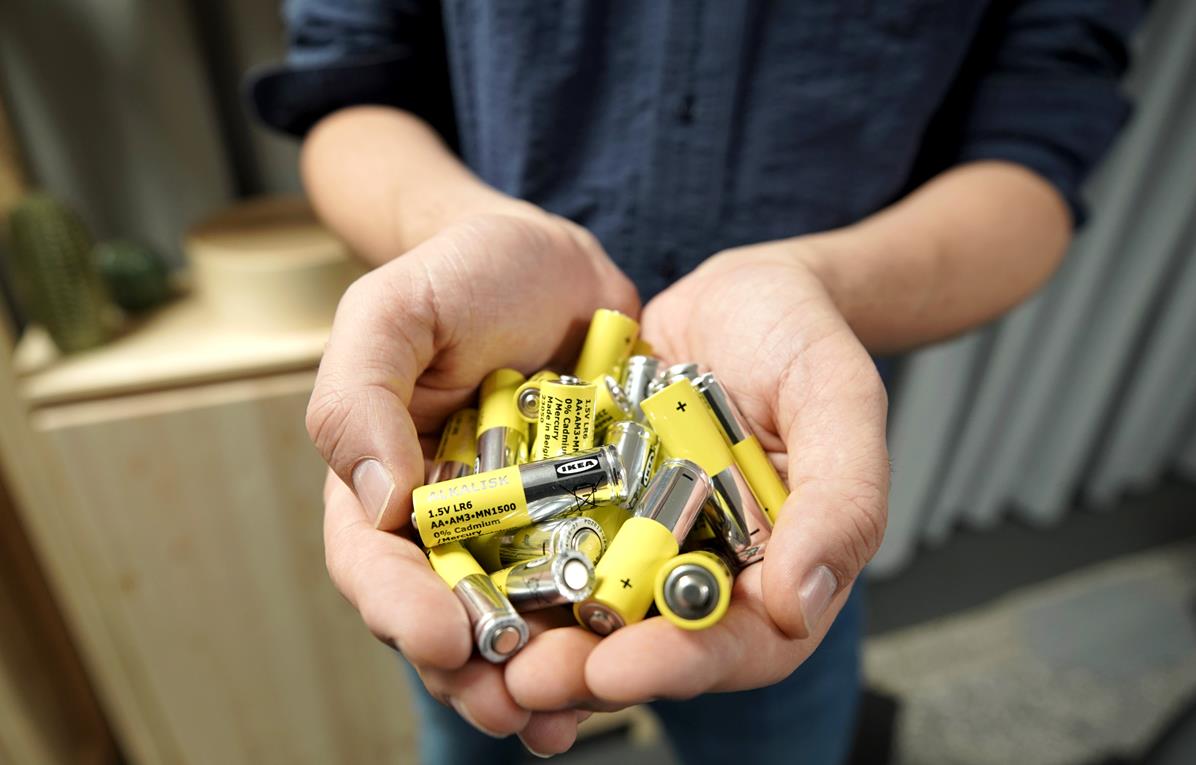IKEA to remove non−rechargeable alkaline batteries by 2021

Following IKEA’s commitment to inspire and enable people to live a healthier and more sustainable life at home, all non-rechargeable alkaline batteries will be removed from the global home furnishing range by October 2021. With this decision, IKEA wishes to inspire consumers who need to frequently use batteries to make a switch to rechargeable batteries. Regular use over time enables consumers to both save money and reduce waste at home.
Several current comparative Life Cycle Assessment studies show that the environmental impact of alkaline batteries is higher compared to rechargeable nickel-metal hydride batteries (NiMH) when used in common household devices that have a high energy consumption and are therefore charged on a regular basis – such as toys, flashlights, portable speakers or cameras.[1]
Already after 10 charges of a rechargeable NiMH battery, such as the LADDA range sold in IKEA stores, greenhouse gas emissions are lower as compared to using alkaline batteries to obtain the same amount of energy. When about 50 charges are reached, the overall environmental impact [2] of NiMH batteries is equal or even less than the impact of using alkaline batteries.[3]
“Consumers who need to frequently use batteries can benefit by replacing alkaline with rechargeable batteries. There are substantial savings to be made over time – on the environment as well as their wallets. IKEA globally sold about 300 million alkaline batteries last year, so we see great potential to inspire our customers to adopt new behaviors and use rechargeable batteries to their full potential“, says Emelie Knoester, Business Area Manager at IKEA Range & Supply.
In FY19, IKEA sold about 300 million alkaline batteries globally. Calculations indicate that if – hypothetically – all IKEA customers switched from ALKALISK alkaline batteries to LADDA rechargeable batteries, used them for high-drain devices and charged them just 50 times the global waste reduction would be as much as 5,000 tons on an annual basis. [4] As one LADDA battery can be charged up to 500 times, the potential to reduce additional waste exists.
“We are on a journey to inspire and enable people to live healthier and more sustainable lives within the boundaries of the planet. By phasing out alkaline batteries and focusing on our range of rechargeable batteries, we are taking one step on that journey – offering customers an affordable and convenient solution to prolong the life of products and materials, and reduce waste”, says Caroline Reid, Sustainability Development Manager at IKEA Range & Supply.
The commitment applies globally and includes the ALKALISK range of alkaline batteries. At this point, the lithium-ion button cell battery called PLATTBOJ will be kept in the range as some applications currently being sold by IKEA require a button cell battery to function.
About IKEA
IKEA offers well-designed, functional, and affordable, high-quality home furnishing, produced with care for people and the environment. There are several companies with different owners, working under the IKEA Brand, all sharing the same vision: to create a better everyday life for the many people. IKEA was founded in Sweden in 1943. In the Range & Supply business, IKEA of Sweden AB is responsible for developing, designing and producing home furnishing solutions to address the everyday needs of the many people.
Sources – Comparative Life Cycle Assessment studies of alkaline batteries against rechargeable NiMH batteries:
- Dolci, G., Tua, C., Grosso, M. and Rigamonti, L., 2016. Life cycle assessment of consumption choices: a comparison between disposable and rechargeable household batteries. The International Journal of Life Cycle Assessment, 21(12), pp.1691-1705.
- Mahmud, M.A., Huda, N., Farjana, S.H. and Lang, C., 2019. Comparative life cycle environmental impact analysis of lithium-ion (LiIo) and nickel-metal hydride (NiMH) batteries. Batteries, 5(1), p.22.
- Parsons, D., 2007. The environmental impact of disposable versus re-chargeable batteries for consumer use. The International Journal of Life Cycle Assessment, 12(3), p.197.
- Menet, J.L. and Gruescu, I.C., 2013, November. Comparative Life Cycle Assessment Of Alcaline Cells And Ni-Mh Rechargeable Batteries
[1] Comparative Life cycle analysis of alkaline batteries against rechargeable NiMH batteries. Dolci et al., 2016; Mahmud, 2019; Parsons, 2007, and Menet and Gruescu, 2013.
[2] Climate change, acidification, eutrophication (terrestrial, freshwater, and marine), freshwater ecotoxicity, human toxicity (cancer effects and noncancer effects), particulate matter, water resource depletion, and mineral and fossil resource depletion)
[3] Comparative Life cycle analysis of alkaline batteries against rechargeable NiMH batteries. Dolci et al., 2016; Mahmud, 2019; Parsons, 2007, and Menet and Gruescu, 2013.
[4] Calculations are based on the comparative LCA studies listed in footnote 1, extrapolated to LADDA and ALKALISK batteries, based on FY19 sales figures of LADDA and assuming all LADDA batteries are charged 50 times according to IEC 61951-2 Ed.3 (2011) standards and in high-drain devices.




